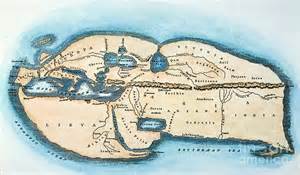Strabo was a Greek explorer and writer famous for a major work on geography.
 Born in about 63 B.C. into a rich family in the Black Sea region of Pontus, which is modern-day Turkey, he was a curious youth who wanted to learn more about the people and land around him. Like most scholarly inclined youth, Strabo studied under a series of tutors, some famous. His first well-known tutor was Aristodemus, a master of rhetoric who counted sons of Roman generals among his flock. It was under Aristodemus's direction that Strabo read and absorbed the likes of Homer. (Strabo would later defend Homer's ideas of geography, as set out in the Iliad and, especially, the Odyssey, in the face of counter-arguments that the entirety of both epic poems were mythical in content.)
Born in about 63 B.C. into a rich family in the Black Sea region of Pontus, which is modern-day Turkey, he was a curious youth who wanted to learn more about the people and land around him. Like most scholarly inclined youth, Strabo studied under a series of tutors, some famous. His first well-known tutor was Aristodemus, a master of rhetoric who counted sons of Roman generals among his flock. It was under Aristodemus's direction that Strabo read and absorbed the likes of Homer. (Strabo would later defend Homer's ideas of geography, as set out in the Iliad and, especially, the Odyssey, in the face of counter-arguments that the entirety of both epic poems were mythical in content.)
When he was in his 20s, Strabo moved to Rome; there, he studied under Xenarchus, a prominent tutor at the court of Augustus, and Tyrannion, another famous scholar. Strabo also benefited from the teachings and geographical knowledge of a tutor named Athenodorus, who was well-traveled.
He traveled widely and wrote expansively of his travels. He went, in Africa, to Egypt and Kush and Ethiopia. He went, in Europe, to Tuscany and Rome. In addition, he traveled widely throughout the Mediterranean area.
Strabo wrote about what he saw and heard and believed, in two major works, one of which is lost. Historical Sketches, a 43-volume work that Strabo wrote in Rome in the 1st Century B.C., exists now only in a fragment residing in an Italian university. Geographica, however, survives intact, in 17 books, and provides historians and geographers alike with a vivid picture of what life was like in Strabo's time, in terms of culture and understanding of the world around the people who lived then.
He takes a wide approach to his discussions of the world around him. He cites his predecessors, among them Eratosthenes and Hipparchus, in discussing Greek scientists' efforts in astronomy, geology, and mathematics. He includes descriptions of other subjects, such as history and physics, painting a wide picture of how the people understood and interacted with their world.
Strabo includes descriptions of many aspects of water and earth, including descriptions of floods and droughts and river swells and sediment. He discusses earthquakes and volcanic eruptions and wind and water erosion.
 He also discusses populations, their makeup and settlement patterns. And, he provides one of the first known discussions of fossils.
He also discusses populations, their makeup and settlement patterns. And, he provides one of the first known discussions of fossils.
Sources differ on when precisely Strabo wrote his two famous works. He lists some dates in Geographica; one of these dates is for an event that happened in A.D. 23, when he was in his 80s, but scholars differ on whether they think he wrote the entirety of the book when he was that old or whether he was revising a previous version of the work.
Strabo died in A.D. 24. His Geographica lived on, however, in the Byzantine tradition in limited form. A Latin translation appeared in the 15th Century, and a version in modern Greek appeared in the 16th Century. Translations into English, French, and German came later.